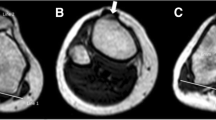Abstract
Purpose
The aim of this study was to report normal values of the tibial tuberosity–trochlear groove distance (TTTG) in males and females and assess the reliability of MRI in measuring TTTG.
Methods
Patients presenting with a suspected meniscus injury without any patellofemoral or ligamentous instability, and arthroscopically normal cruciate ligaments and patellofemoral joints were included in the study. K-PACS© was used for MRI analysis and was performed by three observers blinded to each others’ measurements.
Results
One hundred patients (57 males, 43 females) were recruited from 2006–2010. The mean TTTG in males was 9.91 mm (95% CI 8.9–10.8 mm) and in females 10.04 mm (95% CI 8.9–11.1). The coefficient of variation was <10% for both intra and inter-observer analysis.
Conclusions
The normal TTTG distance is 10 ± 1 mm with MRI being a reliable method of measurement. Literature supports a high degree of variability in reporting TTTG. This study establishes normal TTTG values, which will help in the assessment and treatment of patellofemoral disorders.


Similar content being viewed by others

References
Dejour H, Walch G, Nove-Josserand L, Guier C (1994) Factors of patellar instability: an anatomic radiographic study. Knee Surg Sports Traumatol Arthrosc 2(1):19–26
Nagamine R, Miura H, Inoue Y, Tanaka K, Urabe K, Okamoto Y, Nishizawa M, Iwamoto Y (1997) Malposition of the tibial tubercle during flexion in knees with patellofemoral arthritis. Skeletal Radiol 26(10):597–601
Wittstein JR, Bartlett EC, Easterbrook J, Byrd JC (2006) Magnetic resonance imaging evaluation of patellofemoral malalignment. Arthroscopy 22(6):643–649
Alemparte J, Ekdahl M, Burnier L, Hernández R, Cardemil A, Cielo R, Danilla S (2007) Patellofemoral evaluation with radiographs and computed tomography scans in 60 knees of asymptomatic subjects. Arthroscopy 23(2):170–177
Lustig S, Servien E, Aït Si Selmi T, Neyret P (2006) Factors affecting reliability of TT-TG measurements before and after medialization: A CT-scan study. Rev Chir Orthop Reparatrice Appar Mot 92(5):429–436
Saudan M, Fritschy D (2000) AT-TG (anterior tuberosity-trochlear groove): interobserver variability in CT measurements in subjects with patellar instability. Rev Chir Orthop Reparatrice Appar Mot 86(3):250–255
Wittstein JR, O’Brien SD, Vinson EN, Garrett WE Jr (2009) MRI evaluation of anterior knee pain: predicting response to nonoperative treatment. Skeletal Radiol 38(9):895–901
Hendricks WA, Robey KW (Ann.91936) The sampling distribution of the coefficient of variation. Math Statist 129–132
Goutallier D, Bernageau J, Lecudonnec B (1978) The measurement of the tibial tuberosity. Patella groove distanced technique and results (author’s transl). Rev Chir Orthop Reparatrice Appar Mot 64(5):423–428
Wagenaar FC, Koëter S, Anderson PG, Wymenga AB (2007) Conventional radiography cannot replace CT scanning in detecting tibial tubercle lateralisation. Knee 14(1):51–54
Shakespeare D, Fick D (2005) Patellar instability-can the TT-TG distance be measured clinically? Knee 12(3):201–204
Dejour H, Walch G, Neyret P, Adeleine P (1990) La dysplasie de la trochlee femorale. Rev Chir Orthop 76:45–54
Smith TO, Davies L, Toms AP, Hing CB, Donell ST (2010) The reliability and validity of radiological assessment for patellar instability. A systematic review and meta-analysis. Skeletal Radiol [Epub ahead of print]
Schoettle PB, Zanetti M, Seifert B, Pfirrmann CW, Fucentese SF, Romero J (2006) The tibial tuberosity-trochlear groove distance; a comparative study between CT and MRI scanning. Knee 13(1):26–31
Stäubli HU, Dürrenmatt U, Porcellini B, Rauschning W (1999) Anatomy and surface geometry of the patellofemoral joint in the axial plane. J Bone Joint Surg Br 81(3):452–458
Maquet P (1976) Advancement of the tibial tuberosity. Clin Orthop Relat Res 115:225–230
Utting MR, Mulford JS, Eldridge JD (2008) A prospective evaluation of trochleoplasty for the treatment of patellofemoral dislocation and instability. J Bone Joint Surg Br 90(2):180–185
Schöttle PB, Fucentese SF, Pfirrmann C, Bereiter H, Romero J (2005) Trochleaplasty for patellar instability due to trochlear dysplasia: A minimum 2-year clinical and radiological follow-up of 19 knees. Acta Orthop 76(5):693–698
DeJour D, Saggin P (2010) The sulcus deepening trochleoplasty—the Lyon’s procedure. Int Orthop 34:311–316
Feller JA, Amis AA, Andrish JT, Arendt EA, Erasmus PJ, Powers CM (2007) Surgical biomechanics of the patellofemoral joint. Arthroscopy 23(5):542–553
Conflict of Interest
Authors declare that they have no conflict of interest.
Author information
Authors and Affiliations
Corresponding author
Rights and permissions
About this article
Cite this article
Pandit, S., Frampton, C., Stoddart, J. et al. Magnetic resonance imaging assessment of tibial tuberosity–trochlear groove distance: normal values for males and females. International Orthopaedics (SICOT) 35, 1799–1803 (2011). https://doi.org/10.1007/s00264-011-1240-8
Received:
Accepted:
Published:
Issue Date:
DOI: https://doi.org/10.1007/s00264-011-1240-8



